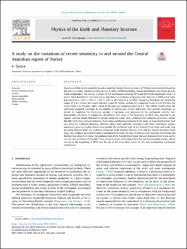| dc.contributor.author | Öztürk, Serkan | |
| dc.date.accessioned | 2020-10-26T12:20:42Z | |
| dc.date.available | 2020-10-26T12:20:42Z | |
| dc.date.issued | 2020 | |
| dc.identifier.issn | 0031-9201 | |
| dc.identifier.issn | 1872-7395 | |
| dc.identifier.uri | https://doi.org/10.1016/j.pepi.2020.106453 | |
| dc.description.abstract | Variations of the recent seismicity in and around the Central Anatolian region of Turkey were evaluated based on the seismic b-value, standard normal deviate Z-value, GENAS modelling, annual probabilities and return periods of the earthquakes. The catalog includes 16,702 earthquakes between 1974 and 2019 with magnitudes from 1.0 to 6.3. Time distribution of b-value shows that there is a tendency to decrease after the year of 2002 and b-value decreased from 1.58 +/- 0.03 to 1.25 +/- 0.05 at the beginning of 2019. Annual probabilities for magnitude ranges of 3.0-4.0 have the values between 3 and 30. Return periods for magnitude levels of 5.0-5.5 have the values from 5 to 20 years, and a value of 80 years for magnitude level of 6.0. The GENAS results show the significant temporal variations in the number of earthquakes smaller and larger than specific magnitude intervals by supplying the beginning periods of increases and decreases in the earthquake activity rate. Remarkable reductions in region-time distribution of b-value at the beginning of 2019 were detected in the regions covering Nigde fault and its vicinity along the south, west, northwest and southwest directions, among the Mut Fault Zone, Karsanti-Karaisali Fault Zone and Karatas-Osmaniye Fault Zone, in and around Surgu fault and along its northwest direction, between Surgu fault and East Anatolian Fault Zone. Significant seismic quiescence areas in Z-value distribution include the northwest ends of the Tuzgolu Fault Zone and study area including Akpinar fault, the northeast of Salanda fault, between Salanda fault and the Central Anatolian Fault Zone, the northeast parts of the Central Anatolian Fault Zone, the west of Malatya fault, between Surgu fault and the East Anatolian Fault Zone, the southeast end of the Tuzgolu Fault Zone, Karsanti-Karaisali Fault Zone and its vicinity, the southwest of Tuzgolu. Thus, these anomaly areas observed in the Central Anatolian region and its vicinity at the beginning of 2019 may be one of the most likely zones for the next strong/large earthquake occurrences. | en_US |
| dc.language.iso | eng | en_US |
| dc.publisher | Elsevier | en_US |
| dc.relation.ispartof | Physics of The Earth and Planetary Interiors | en_US |
| dc.rights | info:eu-repo/semantics/closedAccess | en_US |
| dc.subject | [No Keywords] | en_US |
| dc.title | A study on the variations of recent seismicity in and around the Central Anatolian region of Turkey | en_US |
| dc.type | article | en_US |
| dc.relation.publicationcategory | Makale - Uluslararası Hakemli Dergi - Kurum Öğretim Elemanı | en_US |
| dc.description.wospublicationid | WOS:000526831300005 | en_US |
| dc.description.scopuspublicationid | 2-s2.0-85080101768 | en_US |
| dc.department | Fakülteler, Mühendislik ve Doğa Bilimleri Fakültesi, Jeofizik Mühendisliği Bölümü | en_US |
| dc.identifier.volume | 301 | en_US |
| dc.identifier.doi | 10.1016/j.pepi.2020.106453 | |
| dc.authorscopusid | 57188980040 | |


















